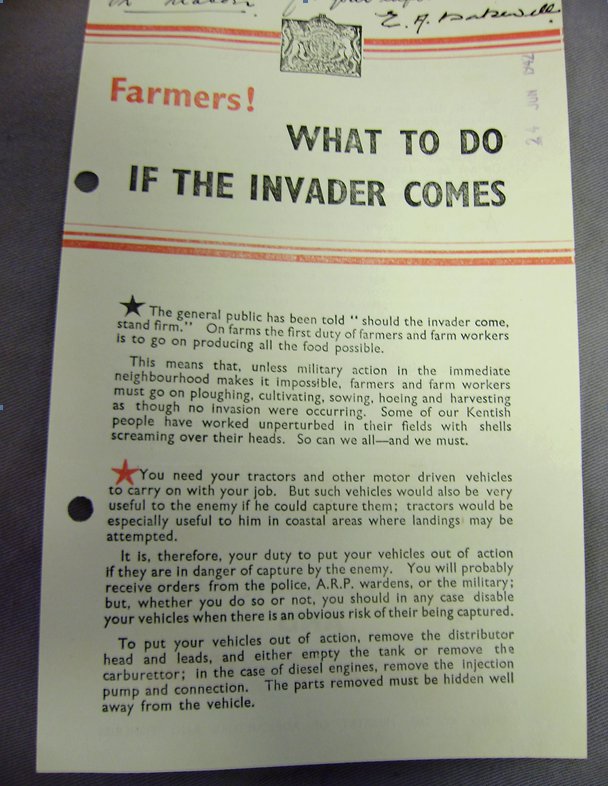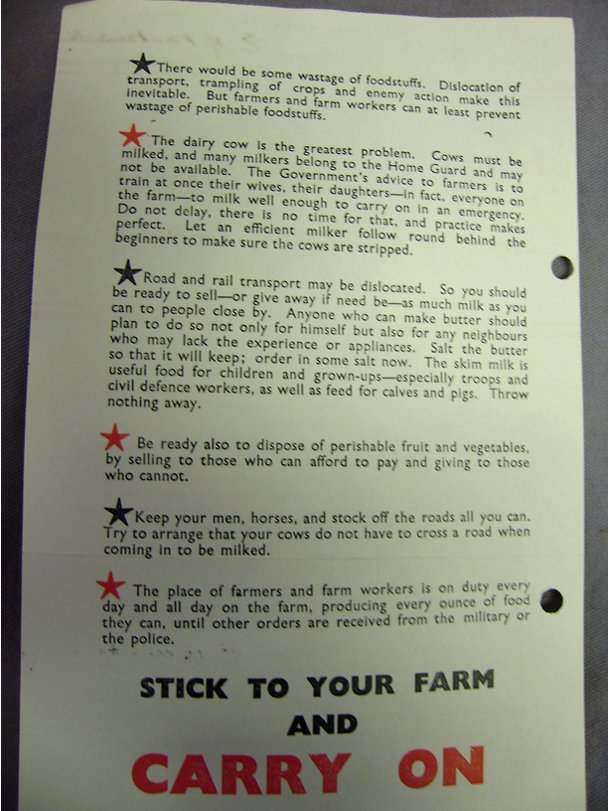![]()
WORLD WAR II
INVASION STRATEGY
The Bingham District Rural District Council (RDC) played a central role in planning for the Second World War. Minutes of the RDC meetings show that as early as 1937 an Air Raid Precautions Committee (ARP) was established to consider the appointment of wardens and arrange training. In 1938 the RDC divided the district into several zones and looked into the requirement for wardens, first aid posts, ambulances and other matters in each of the zones. In January the next year, 1939, they set up an Evacuation Committee to prepare to receive over 2000 evacuees from Sheffield. These duly arrived in June 1940.
It is likely that plans for Bingham in the event of a German invasion were also prepared at an early stage, but the earliest copy of such a document present in the Nottinghamshire Archives was prepared by the Bingham Invasion Committee on 13th April 1942. This appears to be rather late because after the Germans invaded the Soviet Union in the summer of 1941 the threat of an invasion of these shores diminished considerably. However, it seems to show that despite this there was no let up in vigilance or preparedness.
Summary of the Strategy document
Work parties lists
Advice to farmers
Report dated 20th May 1942
Summary of the Strategy document
Jim Johnson prepared the following précis of the documents dealing with the Invasion Strategy held in Nottinghamshire County Archives. They are numbered Cc/cd/1/14/4, cc/cd/1/14/37/38 and cc/cd/1/11/4:
Codename Operation ‘BUGBEAR’(the enemy is coming).
The postulated invasion would come via the Wash and Lincolnshire. Grantham Road would become a ‘wall of fire’ and the homes would be evacuated. Initially troops and home guard would be deployed against the enemy and operations by individuals discouraged. All residents would be encouraged to stay put and carry on, whatever that meant.
Citizens were organised into work parties, to cover maintenance, repair, nursing, food and medical supplies distribution. Limited resources would be available, i.e. weapons and ammunition! The Church bells were put under the command of 2nd Lt Wilkinson, assisted by the verger J. Bellamy and would only be rung on his command as a rallying warning.
All roads would be closed to non-essential traffic. Messengers, mostly teenagers, were to be deployed as required. 15 were recruited.
All food and medical supplies would be confiscated and central feeding stations arranged; i.e. the Methodist Hall and the Chesterfield Arms Inn.
The following would also be organised:
- Hospital - the County Institution on Nottingham Road. (formerly the Workhouse)
- One house in each street to act as a nursery.
- Home Guard HQ at Mr Gillot’s premises in Newgate Street (number 8)
- ARP (Air Raid Precaution) in the Market Square Rural district Council premises.
- Mortuaries, the Drill works on Nottingham Road, (now the Foley’s Books Warehouse).
- The dead would be buried in a field north of Nottingham Road opposite the County Institution under the control of Chas Coleman undertaker.
- Fire: in addition to the three pumps held by the National Fire Service, (these were deemed insufficient by the invasion committee), there were 22 stirrup pumps in private hands for use against incendiaries. It was deemed that the piped water supply to Bingham was inadequate for fire fighting but that dammed streams and wells would be of more use.
- The Tenet for the plan was, “Precautionary, it would not bring the invasion any nearer but the idea was to be ready “WHEN it comes”.
- Letters were sent to each resident detailing their role and necessary training.
- Exercise “ Summit “was mounted on 18 and 19 August 1942 to test arrangements, communications and enemy sighting strategy. The successes or failures were not reported.
A document criticised the Home Guard Commander, Maj. Pentecost from Nottingham for being unrealistic and being unaware of his full responsibilities.
The defence of RAF Newton would be the responsibility of the ground staff, the RAF Regiment being moved away except for Anti-Aircraft units.
Further details are set out in a transcript of the report of the Bingham Invasion Committee CC/CD/1/11/4 dated 20th May 1942 found in Nottinghamshire Archives. It supplements another report dated 13th April 1942.
Advice to Farmers


Transcription of document CC/CD/1/11/4 held in Nottinghamshire Archives
Private and confidential
Report of Bingham Invasion Committee
In amplification of previous report dated 13th April 1942
1. Arrangements for Headquarters
A room is available in the A.R.P. Control Centre, Market Place, Bingham, telephone number Bingham 259. Not situated alongside Military Headquarters which are at Newark. Local Home Guard Headquarters are, however, situate at the house of Messrs Gillott Bros, Newgate Stree, Bingham, and near to the Committee’s Headquarters. Home Guard telephone number Bingham 335.
Messengers required about 15. These have not yet been actually recruited but a list has been prepared for that purpose.
Deputy Chairman is Mr Geo. H. White, Bingham (Chairman of the Bingham Parish Council).
2. Tools and Equipment
The following have been ascertained to be available:-
(1) Fire Fighting(a) From existing A.R.P. or Civil Defence Services – ample equipment at N.F.S. Fire Station augmented by Stirrup Pumps at houses occupied by various Wardens and Firemen.
(b) From other sources in private ownership – 22 Stirrup Pumps privately owned and available in emergency
(2) Medical Services and Gas Cleaning
In addition to usual equipment at the County Institution whaihc has been selected as a Hospital Shelter, a good supply of Camp beds and blankets is available from other source. Extra bedding, blankets, equipment, dressings and clothes are stored locally
(3) Works services and
(5) Trench Shelters and LatrinesAvailable tools – 93 shovels, 26 picks, 19 spades and tomahawks, also two or three lorries (two with drivers). The foregoing belong to the Notts. County Council Highway Dept, but members of the working squads have mostly tools of their own, such as spades etc., which could be relied upon if necessary.
(4) Welfare Services
Supplies of blankets, clothing, food etc., are understood to be available at the two rest centres.
3. Accommodations marked for Essential Services
(a) Casualties. The County Institution, Bingham, has been selected as Hospital Shelter, to provide about 50 beds by re-arrangement of existing accommodation there, and by boarding out walking cases, either in private houses, or possibly in Rest Centres. In addition, it is suggested that Rest Centres could be used as temporary casualty stations, if not in use at the time for their primary purpose.
(b) Refugees and Homeless. It is anticipated that the Rest Centres already established will be sufficient to meet requirements, but if not, further accommodation could doubtless be improvised at short notice.
(c) Gas Cleaning Legion Hall, Bingham
(d) Cooking. Chesterfield Arms Hotel, Bingham.
Y.W.C.A. Hostel, Tithby Road Bingham(e) Feeding At places under (d) above.
(f) Mortuaries. The Drill Works, Nottingham Road, Bingham is earmarked by the R.D.C, as a temporary mortuary, and is regarded by the Council as being available and sufficient for the purpose.
4. Police Arrangements
These are entirely under the control of the Chief Constable and are not regarded as the immediate concern of the Committee.
5. Fire Fighting
Number of personnel:-
Attached to existing A.R.P. or Civil Defence
Services. (including local N.F.S.) 35
Additional thereto approximately 50
Auxiliary arrangements
Number of Fire Parties “ 15Equipment disposed in various parts of the village – See answer to paragraph 2(1) – further equipment is being asked for
6. Medical Arrangements and Gas Cleaning
Number of personnel:-
(a) Attached to existing A.R.P. or Civil Defence Services 34
Additional thereto approximately 75
7. Works Services
Number of personnel:-
(a) Attached to existing A.R.P. or Civil Defence Services.
Rescue Nil
(b) Repair Nil
(c) Decontamination NilAdditional to (a) and (b) approximately 80
Additional to (c) Nil
8. Welfare Arrangements
Number of personnel:-
(a) Attached to existing A.R.P. OR civil Defence
Services (Personnel of two Rest Centres). 60
(b) Additional thereto Nil
(Above number regarded as sufficient)
9. Cooking and Fuel
See answer to paragraph 3(d)
10. Water
Bingham is partly supplied from the Nottingham Corporation mains but largely from wells. It is believed that in an emergency all needed for domestic purposes could be supplied from the wells now actually in use. In regard to Fire Fighting, the pressure on the mains is not very satisfactory, but there are limited reserves of static water which it is believes would prove reasonably sufficient for any nearby fire. Two additional canvas steel-frame dams are really necessary in this district.
11. Food
The Committee definitely understand from the Food Executive Officer that on Phase B coming into operation Food Officers would take over all available stocks of food and be responsible for distribution so that it appears no steps on the part of the Committee are needed. Should, however, the Food Department need any help in the matter of distribution the Committee could in all probability supply it from their list of available personnel.
12. Latrines
Left for further consideration. If these should prove necessary they could quickly be arranged for. A good deal of material for the purpose is already available.
13. Burial of the Dead
It is proposed that arrangements for dealing with fatal casualties should be placed in the hands of Mr Chas. Coleman, undertaker, Bingham who already occupies a responsible position in this connection under existing Civil Defence Plans. Site proposed is a field north side of Nottingham Road, opposite the County Institution.
14. Trench Shelters
This matter is being left for further consideration at a later stage. There are a considerable number of surface shelters in Bingham and it is thought that possibly trench shelters are not necessary. Any requirements of the Military Authorities would, however, be dealt with on being communicated to the Committee.
15. Information to the Public.
A representative meeting has already been held by invitation and a public meeting is not in the circumstances regarded as necessary. The Committee have authorised their Chairman to sign on their behalf notices to the public during Phase B, for posting on the official notice board, such notices to be countersigned by the local Inspector of Police.
16. Training
It is proposed that wherever necessary or desirable appropriate training or instruction shall be given to the ancillary services.
17. Census
A census has been taken by the A.R.P. Wardens, and from the information gathered is this way the Committee have prepared lists of persons (link to Working Parties) suitable for certain services under the undermentioned heads, viz:-
Men suitable for work parties
Men suitable as stretcher bearers, or for other First Aid work
Women suitable for inclusion in Fire Parties
Women suitable for dealing with casualties etc., under trained staff
Boys between 14 and 16 years of age, suitable for messengers.Broadly speaking, the persons included in these lists are such as are not already attached to any of the Civil Defence Services. This method has been adopted as, in the opinion of the Committee, preferable to the calling of a public meeting to obtain volunteers.
Signed………………..
Chairman of the CommitteeMay 20th 1942
